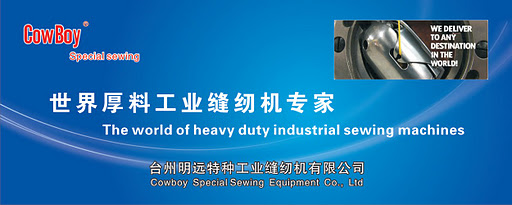Sailmaker’ job involve lie out, cut, assemble and repair sails that may be made from high tech textiles, such as carbon fibre, Zylon and Vectran, and by a lamination cloth as well as canvas. If you're going to start your sail making business, the first thing you'll need is a good industrial sewing machine.
http://www.automatic-sewing.com/zigzag-sail-making-sewing-machine.htm
Using the specialized sewing machine to ensure the panels are sewn together and heavy wear areas are reinforced with protective patches.
General there are two types industrial sewing machines for sail makers and repairs: a basic heavy duty straight lockstitch sewing machine like (Cowboy #740 Top and bottom feed lockstitch sewing machine with large hook (www.cowboysew.com/product2.htm), for detailed work and finishing, for example binding tape, sewing zippers & piping cords, attaching metal ring and straight stitching for day sailing, cotton sails, spray hoods, boat covers, interior & exterior boat upholstery etc. Most sail loft s have heavy duty zigzag industrial sewing machine like Durkopp Adler 166 or Adler 266-1, for sewing heavy corners, patches, attaching thick webbing, heavy duty canvas & sail work. The production of these machines stopped decade ago, you cannot find the new machine in today market, Sailmaster 9266 extra heavy duty zigzag sewing machine (www.cowboysew.com/product4.htm) is the good replacement for sailmakers and repairs.
In modern sail making industry, triple zigzag (3-step zigzag) is necessary, so you need to have a cam-controlled zigzag industrial sewing machines, which has different cams for straight stitch, 1-step (2-point), 2-step (3-point) and 3-step zigzag (4-point), even 6-step zigzag. Durkopp Adler 72525 is the good sail maker sewing machine for sewing of light to medium weight materials, great for manufacturing and repairing surf sails, spinnakers, wetsuits, tents, awnings etc. But the price of this machine is too high to be affordable by most sailmakers. So many sail makers purchases the replacing machine Sailmaster 9518-30 long arm medium weight zigzag sewing machine (www.cowboysew.com/product5.htm).
For making large-surface sport sails, a long arm zigzag machine with large clearance was required. Durkopp Adler 366-76-12-HM is the specialized sail maker sewing machine for heavy sails. Before of high cost, many sail makers prefer to Sailmaster 9366-31HA High and long arm heavy duty zigzag sail making machine(www.cowboysew.com/product5.htm). This sail maker sewing machine is recognized as the ultimate sewing
machine currently available, it out powers all other sail maker sewing
machines, it is capable of powering its needle through 20mm of Dacron, Kevlar
or leather, with its adjustable speed, pitch and zigzag action it can take on
the largest sails you can imagine, described by the European sail makers as the
Porsche of sewing machine, it is without doubt the strongest machine ever
produced.
Anyway it is very important to get a right sewing machine for your sail manufacturing.
http://www.automatic-sewing.com/zigzag-sail-making-sewing-machine.htm
Using the specialized sewing machine to ensure the panels are sewn together and heavy wear areas are reinforced with protective patches.
General there are two types industrial sewing machines for sail makers and repairs: a basic heavy duty straight lockstitch sewing machine like (Cowboy #740 Top and bottom feed lockstitch sewing machine with large hook (www.cowboysew.com/product2.htm), for detailed work and finishing, for example binding tape, sewing zippers & piping cords, attaching metal ring and straight stitching for day sailing, cotton sails, spray hoods, boat covers, interior & exterior boat upholstery etc. Most sail loft s have heavy duty zigzag industrial sewing machine like Durkopp Adler 166 or Adler 266-1, for sewing heavy corners, patches, attaching thick webbing, heavy duty canvas & sail work. The production of these machines stopped decade ago, you cannot find the new machine in today market, Sailmaster 9266 extra heavy duty zigzag sewing machine (www.cowboysew.com/product4.htm) is the good replacement for sailmakers and repairs.
 |
| Adler 266-1 Type extra heavy duty zigzag |
In modern sail making industry, triple zigzag (3-step zigzag) is necessary, so you need to have a cam-controlled zigzag industrial sewing machines, which has different cams for straight stitch, 1-step (2-point), 2-step (3-point) and 3-step zigzag (4-point), even 6-step zigzag. Durkopp Adler 72525 is the good sail maker sewing machine for sewing of light to medium weight materials, great for manufacturing and repairing surf sails, spinnakers, wetsuits, tents, awnings etc. But the price of this machine is too high to be affordable by most sailmakers. So many sail makers purchases the replacing machine Sailmaster 9518-30 long arm medium weight zigzag sewing machine (www.cowboysew.com/product5.htm).
 |
| Adler 525 type zigzag sewing machine for surf sails and spinnaker |
Anyway it is very important to get a right sewing machine for your sail manufacturing.


